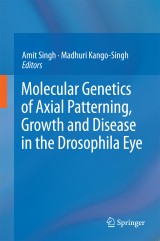Details

Molecular Genetics of Axial Patterning, Growth and Disease in the Drosophila Eye
|
149,79 € |
|
| Verlag: | Springer |
| Format: | |
| Veröffentl.: | 14.09.2013 |
| ISBN/EAN: | 9781461482321 |
| Sprache: | englisch |
| Anzahl Seiten: | 368 |
Dieses eBook enthält ein Wasserzeichen.
Beschreibungen
Undoubtedly, Drosophila melanogaster, fruit fly, has proved to be one of the most popular invertebrate model organisms, and the work horse for modern day biologists. Drosophila, a highly versatile model with a genetic legacy of more than a century, provides powerful genetic, cellular, biochemical and molecular biology tools to address many questions extending from basic biology to human diseases. One of the most important questions in biology focuses on how does a multi-cellular organism develop from a single-celled embryo. The discovery of the genes responsible for pattern formation has helped refine this question, and led to other questions, such as the role of various genetics and cell biological pathways in regulating the crucial process of pattern formation and growth during organogenesis. Drosophila eye model has been extensively used to study molecular genetic mechanisms involved in patterning and growth. Since the genetic machinery involved in the Drosophila eye is similar to humans, it has been used to model human diseases and homology to eyes in other taxa. This book will discuss molecular genetic mechanisms of pattern formation, mutations in axial patterning, Genetic regulation of growth in Drosophila eye, and more. There have been no titles in the past ten years covering this topic, thus an update is urgently needed.
Early eye development: Specification and Determination.- Molecular genetic mechanisms of axial patterning: Mechanistic insights into generation of axes in the developing eye.- Catching the Next Wave: Patterning of the <i>Drosophila </i>Eye by the Morphogenetic Furrow.- Cell Morphogenesis.- Cell Polarity in <i>Drosophila </i>Retina.- Negative regulation for neural patterning in the <i>Drosophila</i> eye.- Cell Adhesion during <i>Drosophila</i> eye development.- Modulation of Developmental Signaling by the Proteostasis Network.- <i>Drosophila </i>eye as a model to study regulation of growth control: The discovery of size control pathways.- Contribution of the <i>Drosophila</i> eye to unraveling the basis of neurodegeneration.- Genetic regulation of early eye development in non-dipteran insects.- Development and evolution of the <i>Drosophila</i> Bolwig’s organ: a compound eye relict.- Index.
<p>Undoubtedly, Drosophila melanogaster, fruit fly, has proven to be one of the most popular invertebrate model organisms, and the work horse for modern day biologists. Drosophila, a highly versatile model with a genetic legacy of more than a century, provides powerful genetic, cellular, biochemical and molecular biology tools to address many questions extending from basic biology to human diseases. One of the most important questions in biology focuses on: how does a multi-cellular organism develop from a single-celled embryo? The discovery of the genes responsible for pattern formation has helped refine this question. Drosophila eye model has been extensively used to study molecular genetic mechanisms involved in patterning and growth. Since the genetic machinery involved in the Drosophila eye is similar to humans, it has been used to model human diseases and homology to eyes in other taxa. This book will discuss molecular genetic mechanisms of pattern formation, axial patterning, growth regulation in Drosophila eye, and more.</p>
<p>Most updated title in the past ten years to cover this topic</p><p>Reviews all molecular genetic aspects of axial patterning in the drosophila eye</p><p>Reviews the research and relates it to how it can transform our understanding of human diseases like cancer?</p><p>Includes supplementary material: sn.pub/extras</p>
Diese Produkte könnten Sie auch interessieren:

Aktinische Keratosen - medizinisches Grundwissen und NEUE Therapieansätze (Carcinomata in situ)

von: Hellene von Waldgraben

9,99 €

Manual clínico de los antidepresivos

von: Victor R. Uriarte Bonilla, Victor R. Uriarte Editorial Alfil, S. A. de C. V.

23,99 €














